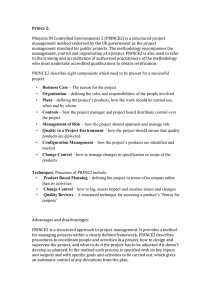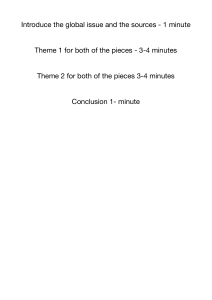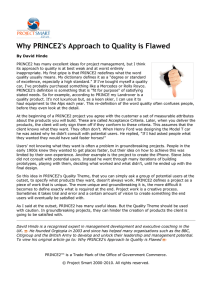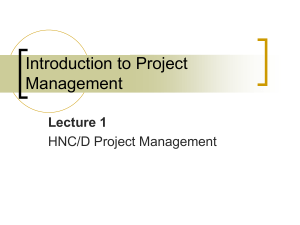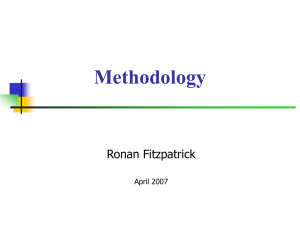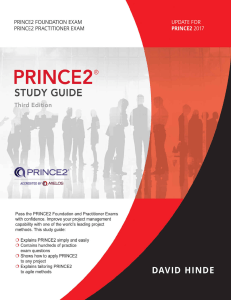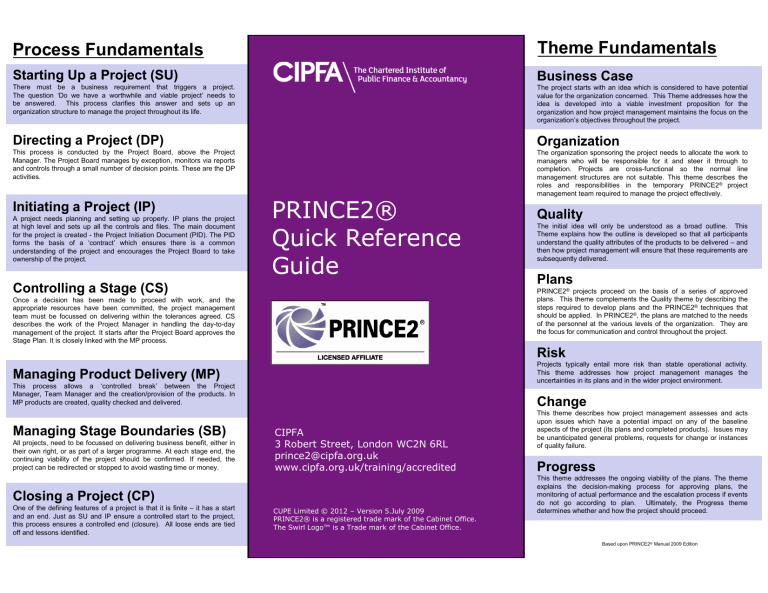
Process Fundamentals Theme Fundamentals Starting Up a Project (SU) Business Case There must be a business requirement that triggers a project. The question ‘Do we have a worthwhile and viable project’ needs to be answered. This process clarifies this answer and sets up an organization structure to manage the project throughout its life. The project starts with an idea which is considered to have potential value for the organization concerned. This Theme addresses how the idea is developed into a viable investment proposition for the organization and how project management maintains the focus on the organization’s objectives throughout the project. Directing a Project (DP) Organization This process is conducted by the Project Board, above the Project Manager. The Project Board manages by exception, monitors via reports and controls through a small number of decision points. These are the DP activities. The organization sponsoring the project needs to allocate the work to managers who will be responsible for it and steer it through to completion. Projects are cross-functional so the normal line management structures are not suitable. This theme describes the roles and responsibilities in the temporary PRINCE2® project management team required to manage the project effectively. Initiating a Project (IP) A project needs planning and setting up properly. IP plans the project at high level and sets up all the controls and files. The main document for the project is created - the Project Initiation Document (PID). The PID forms the basis of a ‘contract’ which ensures there is a common understanding of the project and encourages the Project Board to take ownership of the project. PRINCE2® Quick Reference Guide Controlling a Stage (CS) Quality The initial idea will only be understood as a broad outline. This Theme explains how the outline is developed so that all participants understand the quality attributes of the products to be delivered – and then how project management will ensure that these requirements are subsequently delivered. Plans PRINCE2® projects proceed on the basis of a series of approved plans. This theme complements the Quality theme by describing the steps required to develop plans and the PRINCE2® techniques that should be applied. In PRINCE2®, the plans are matched to the needs of the personnel at the various levels of the organization. They are the focus for communication and control throughout the project. Once a decision has been made to proceed with work, and the appropriate resources have been committed, the project management team must be focussed on delivering within the tolerances agreed. CS describes the work of the Project Manager in handling the day-to-day management of the project. It starts after the Project Board approves the Stage Plan. It is closely linked with the MP process. Risk Projects typically entail more risk than stable operational activity. This theme addresses how project management manages the uncertainties in its plans and in the wider project environment. Managing Product Delivery (MP) This process allows a ‘controlled break’ between the Project Manager, Team Manager and the creation/provision of the products. In MP products are created, quality checked and delivered. Managing Stage Boundaries (SB) All projects, need to be focussed on delivering business benefit, either in their own right, or as part of a larger programme. At each stage end, the continuing viability of the project should be confirmed. If needed, the project can be redirected or stopped to avoid wasting time or money. Change CIPFA 3 Robert Street, London WC2N 6RL prince2@cipfa.org.uk www.cipfa.org.uk/training/accredited Closing a Project (CP) One of the defining features of a project is that it is finite – it has a start and an end. Just as SU and IP ensure a controlled start to the project, this process ensures a controlled end (closure). All loose ends are tied off and lessons identified. CUPE Limited © 2012 – Version 5.July 2009 PRINCE2® is a registered trade mark of the Cabinet Office. The Swirl Logo™ is a Trade mark of the Cabinet Office. This theme describes how project management assesses and acts upon issues which have a potential impact on any of the baseline aspects of the project (its plans and completed products). Issues may be unanticipated general problems, requests for change or instances of quality failure. Progress This theme addresses the ongoing viability of the plans. The theme explains the decision-making process for approving plans, the monitoring of actual performance and the escalation process if events do not go according to plan. Ultimately, the Progress theme determines whether and how the project should proceed. Based upon PRINCE2® Manual 2009 Edition Processes & Activities Starting Up a Project (SU) • Appoint Executive and Project Manager • Capture Previous Lessons • Design & Appoint PM Team • Prepare the Outline Business Case • Select Project Approach & Assemble Project Brief • Plan the Initiation Stage Directing a Project (DP) • Authorise Initiation • Authorise the Project • Authorise a Stage or Exception Plan • Give Ad Hoc Direction • Authorise Project Closure •Plans •Quality •Risk •Organization •Business Case Stages Business Case Themes Used The key philosophy of PRINCE2® is that the project is driven by the Business Case. The focus on the Business Case should be on its totality of business change, not just one element of it. The following diagram shows where the Business Case is created and updated throughout the project life-cycle. Project Mandate Project Brief PID Stages are divisions of the project for management purposes. Each stage is reviewed by the Project Board who approve them one at a time (at an End Stage Assessment). Stages are major decision making points in PRINCE2®. Management stages equate to commitment of resources and authority to spend. Technical stages are groups of specialist skills / activities required to create the specialist products. Technical Stages PID Outline Business Case Refined & Approved Business Case Reasons for the Project Specification Design Business Case Build •Progress •Business Case •Risk Expected Benefits Updated Business Case Test Reviewed Business Case Benefits Review Plan Implement End Stage Report Project Issues End-Stage Assessments (Project Board Decision Points) Controlling a Stage (CS) • Authorise Work Package • Review Work Package Status • Receive Completed Work Package • Review Stage Status • Report Highlights • Capture & Examine Issues and Risks • Escalate Issues & Risks • Take Corrective Action Management Stages Products •Progress •Plans •Quality •Risk •Business Case •Change •Organization •Progress •Change •Risk •Quality In PRINCE2® there are three types of management products, “Baseline”, “Records” & “Reports”. Specialist products are the unique outputs of the project. A.1 A.2 A.3 A.4 A.5 A.6 A7 A.8 A.9 A.10 A.11 A12 A.13 Benefits Review Plan Business Case Checkpoint Report Communication Management Strategy Configuration Item Record Configuration Management Strategy Daily Log End Project Report End Stage Report Exception Report Highlight Report Issue Register Issue Report A.14 A.15 A.16 A.17 A.18 A.19 A.20 A.21 A.22 A.23 A 24 A.25 A.26 Lessons Log Lessons Report Plan Product Description Product Status Account Project Brief Product Initiation Documentation Project Product Description Quality Management Strategy Quality Register Risk Management Strategy Risk Register Work Package Managing Product Delivery (MP) • Accept a Work Package • Execute a Work Package • Deliver a Work Package •Progress •Business Case •Quality From Customer Project Response Customer’s Quality Expectations Acceptance Criteria Project Product Description Quality Management Strategy Quality Components Quality Criteria & Tolerances Product Descriptions PRINCE2® Product-based Planning Technique Quality Methods Quality Responsibilities Quality Register COMMUNICATE PRINCE2® Quality Review Technique Risk Assessment evaluates the risk using the probability of it happening & the impact if it does. Responses are considered to decide the best way forward. PRODUCT Quality & Approval Records CONTROL Closing a Project (CP) • Prepare Planned Closure • Prepare Premature Closure • Hand Over Products • Evaluate the Project • Recommend Project Closure •Progress •Plans •Business Case •Risk •Organization Risk Project management must control and contain risks if a project is to stand any chance of being successful. Assumptions about risk have to be regularly revisited and reconsidered, for example at each End Stage Assessment. Risk requires, identification prior to assessment leading to a plan which is implemented. This Risk Management Cycle diagram shows the relationship between them. • Identify all the Project’s Products. • Define the products in Product Descriptions • Implement and track the Quality Methods employed throughout the Project. QUALITY Managing a Stage Boundary (SB) • Plan the Next Stage • Update the Project Plan • Update the Business Case • Report Stage End • Produce an Exception Plan •Progress •Change •Plans •Quality The specific treatment for quality in PRINCE2® is the focus on products from the outset, requiring systematic activities to: QUALITY •Management products – shown in Appendix A of the manual. The Quality Approach PLANNING Initiating a Project (IP) • Prepare the Risk Management Strategy • Prepare the Quality Management Strategy • Prepare the Configuration Management Strategy • Prepare the Communication Management Strategy • Set up the Project Controls • Create the Project Plan • Refine the Business Case • Assemble the Project Initiation Documentation Acceptance Record Crown Copyright 2009. Reproduced under license from OGC Crown Copyright 2009. Reproduced under license from OGC
